04.10.2006
Game VII V.Topalov - V.Kramnik
1.d4 d5 2.c4 c6 3.Nf3 Nf6 4.e3 e6 5.Bd3 dxc4 With his fifth move white delayed development of his queen's knight thus making Merano setup inappropriate for black, thus Kramnik transposes the game to a Queen's gambit accepted. He must be perfectly familiar with this system, because he used to play it a lot ... but with white pieces.6.Bxc4 c5 7.0-0 a6 8.Bb3 cxd4 9.exd4 Nc6 10.Nc3 Be7 11.Re1 0-0
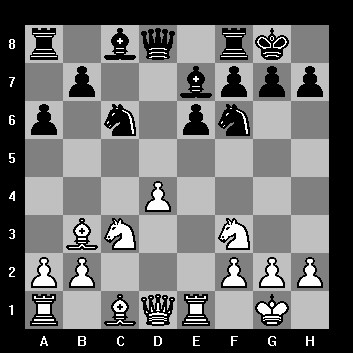
12.a4 A very rare move, Topalov prevents the typical for this variation planned move b7-b5. Previously, as a rule, white finished development by 12.Bf4 or 12.Bg5, an "insinuating" 12.a3 also took place.
12...Bd7 13.Ne5 Be8 14.Be3 Rc8 15.Rc1 Nb4 16.Qf3 White queen proceeds to g3 or h3, from it's going to harass the black king. Topalov must be content with the results of the opening - he's got the initiative, and no simplifications can be foreseen in the nearest future.16...Bc6 17.Qh3
17.Qg3 (with Be3-h6 as one of the ideeas) also deserves attention. For example,after 17...Kh8 move18.Qh3 gains some more weight.
17...Bd5 18.Nxd5 Nbxd5 19.Rcd1! Exchanges favour black: 19.Rxc8 Qxc8 20.Bg5 Qc7 with a safe position for black.
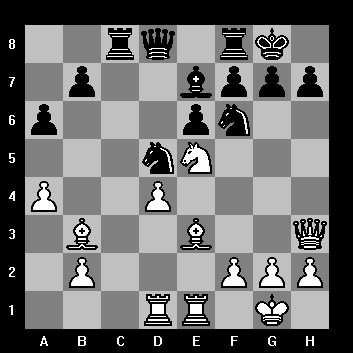
19...Rc7 Exchange on e3 would be positionally desirable for black, but at the moment after 19...Nxe3 20.Rxe3 it's difficult to defend against Nxf7 threat. After white eventually win a rook for his b3-bishop, in a resulting position with a rook and two pawns for two minor pieces chances will be on the white's side. 20.Bg5
20...Qc8 21.Qf3 Rd8 22.h4 h-pawn advance is typical for such positions throwing a puck into opponent's zone. We can recall for example Vladimir Kramnik's victories, that he achieved similar way. 22...h6
23.Bc1 23.Bd2 looked more natural, and an attempt to start simplificationsis risky: 23...Bb4 (after 23...Bd6 reply 24.g4! is dangerous, after which black has exchange hjis bishop on e5, admitting the position to be clearly worse) 24.Bxb4 Nxb4 25.Nxf7!? ( 25.g4!? is also interesting based on the variation 25...Nc6 26.Nxf7 Rxf7 27.Bxe6 Qc7 28.d5 and this position favours white) 25...Kxf7 26.Bxe6+ Qxe6 27.Rxe6 Kxe6 and now 28.g4! , discoordinating black pieces. 23...Bb4 24.Rf1
24...Bd6 Black is ready to take out e5-knight at any moment, it's difficult to suggest any other moves here driven by clear ideas. Now 25.g4!? deserves attention: 25...Bxe5 26.dxe5 Nd7 27.g5! h5 [black definitely doesn't need opening more files: 27...hxg5 28.Bxg5 Nxe5 29.Qg3] 28.Qxh5 Nxe5 29.Qe2 A double-edged position arises in which white's chances are somewhat superior. 25.g3 Probably, Topalov decided to keep the tension without forcing the position immediately, clearly taking into account Kramnik's having not so much time: black has less than half an hour mins, while white has some 1hr15 mins 25...b6
26.Qe2 b6 An interesting position arose, it's not so easy to suggest a move to improve the position. Probably, Kramnik decides to put the queenside pawns on the dark squares meanwhile freeing a nice square for his queen on b7. 26.Qe2 Ne7 This move looks somewhat dubious. 26...Qb7 seemes to be more reliable. 27.Rfe1 Now black faces an unpleasant choice, either to return back with the knight or...
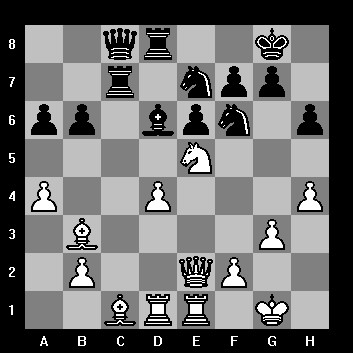
27...Bxe5 28.dxe5 Rxd1 29.Qxd1 Nfd5 [29...Nd7 deserved some attention, directing tio c5.] 30.Bd2 Rc5 31.Qg4 The position got stabilized, white has though not big but stable advantage.
31...Nf5 32.Qe4 b5
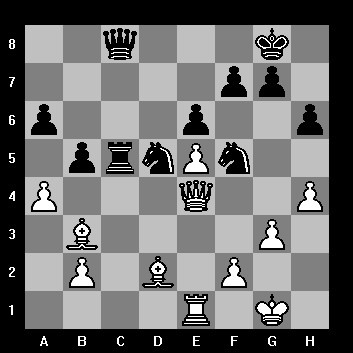
33.h5?! This certainly structurally desirable move gives black pieces some concrete counterplay, Nf5 is constantly threatening "to jump" to d4. 33.a5 appeared to be more consistent with the position.] 33...bxa4! 34.Qxa4 Rb5 35.Rc1 Qb7 36.Bc2 Nb6 White seems to have to sacrifice a pawn: 37.Qg4 Nd7 38.Be4 Nxe5 39.Qf4 followed by Bc3, getting enough compensation for it.
37.Qg4 Rxb2! Correct and solid solution of the position. Black having knights, he should better prefer to reduce playing to the fight just on one side. Possible further continuation may be, for example, 38.Bc3 Rb5 39.Bxf5 exf5 40.Qxf5 Qc6 and black must not lose. 38.Be4 Qd7 39.Be1 Topalov prefers to keep the tension at the cost of a pawn. 39...Nd5
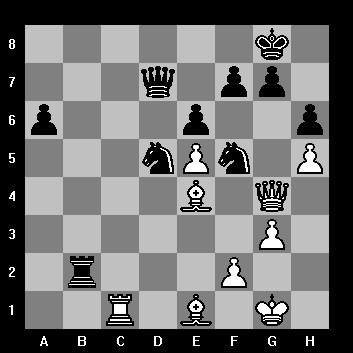
40.Bd3 Nb4
Now 41.Be4 is worth trying. Tempting on the first sight 41...Nd3 in a fact creates problems only for black: 42.Qd1 Nxe5 43.Qxd7 Nxd7 44.Rc8+ Nf8 [44...Kh7 45.Bc3] 45.Bc3 Nd6 46.Rc6 winning a quality or 45...Rb5 46.Bxf5! exf5 47.Bd4 f4 48.gxf4! Rxh5 49.Be5 with winning chances. Of course, 41...Nd5 leads to a repetition, and white may take time to decide if he's content with it.
41.Bf1?! An error, now after 41...Nd3 playing for two results must start - white is beyond any risk of winning. 41...Nd3 42.Qd1 Nxe5 43.Qxd7 Nxd7 44.Rc8 At this moment, on 44...Kh7 white is likely to respond with 45.Rc7 Nf6 46.Bd3 mainteining the tension. 44...Nf8 is quite possible, but the pin on th 8th rank is unpleasant, black will find it by far not easy to deploy his forces.
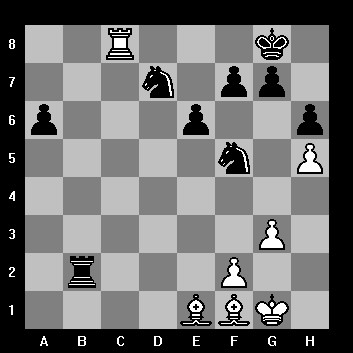
44...Kh7 The safest. After the alternative 45...Nf6 46.Rxf7 (or 46.Bd3 Ra2 47.Rf7 Ra1 48.Kf1 Nh5 49.Ra7) Rb1 47.Ba5 Ne4 (after 47...Nxh5?! 48.g4 Kg8 49.Ra7 black is under a risk of their knight losing its way in variations like 49...Nfg3 50.gxh5 Nf1 51.Kg2) a sharp position could arise in which the most probable result would be draw. Currently the contuinuation 46.Rxd7 [ 46.Bc3 doesn't change much: 46...Nb6 47.Rxf7 Nd5 48.Be5 Nde7 (or 48...Re1 49.Bb2 Rb1=) 49.Bf6 Nd5 , with moves repetition] 46...Rxe1 47.Kg2 must lead to draw. 45.Rc7 Rb1 46.Rxd7 Rc1
47.Rxf7 Topalov decides to take the pawn immediately, this must hardly change the outcome anyway. 47...a5 48.Kg2 Kg8 49.Ra7 Re5 50.g4 Nd6 51.Bd3 Kf8 52.Bg6 Rd5 53.f3 e5 54.Kf2
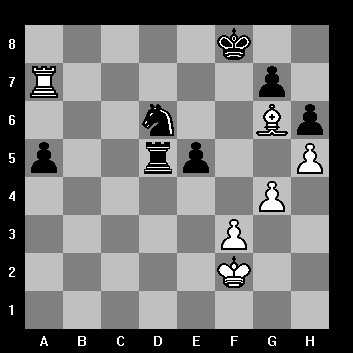
54...Rd2 55.Ke1 Rd5 56.Ke2 Rb5
Wandering about with his rook black secures draw. 57.Rd7 Rd5 58.Ra7 Rb5 59.Bd3 Rd5 60.Bg6Draw.
-------------------------
Summary.
It was the third game in a row that Vladimir Kramnik had to play with black - a unique case in the world match practice! Today he had to solve tasks far from simple, and he's stood the hard test fine. Having encountered opening problems in the first part of the game, Vladimir kept on playing rather slowly, while his opponent was showering out with his moves as if from a chaingun, having stored a whole extra hour as compared to Kramnik. In the opening Topalov applied a rare but very poisonous move 12.a4 and obtained a long-term initiative. Nevertheless, in a complicated fight Vladimir acted clearly more precise than his opponent and the scales seemed gradually being tipped to his favour. Yet black's accumulated advantage turned out to be insufficient for a victory, thus draw is a result justified by the course of the game. By the way, in the games played a paradoxical situation arises: imho, Topalov played the two first games better than Kramnik, but suffered frustrating losses. Starting from the third game, Volodya plays better than his opponent (clearly, with the exclusion of game 5, in which Danailov gained revenge instead of Topalov. By the way, this person today has given birth to another freak of epistolary nature - a press-release in a form of protesting accusation, obviously attempting to seize the initiative in the match. We'd like to hope that this new provokation will not work), but can not make it enough to win. Outplaying his opponent, he always bears in mind his leading position in the match, keeps on securing safe game with likely drawish outcome in positions where he would fight for victory, should the situation be different. In the next eighth game of the match, the opponents are supposed to swap the colour of pieces, thus Vladimir Kramnik will play white at last, after all it had been long ago that he had white last time, in September...
